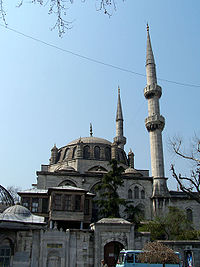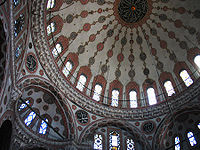- Emetullah Rabia Gülnûş Sultan
-
Emetullah Râbi'a Gülnûş Sultan 
Born 1642
Rethymno, Crete, Republic of VeniceDied 6 November 1715 Ethnicity Greek Known for Valide Sultan Religion Orthodox Christian or Catholicism, subsequently converted to Islam after her capture Spouse Mehmed IV Children Mustafa II, Ahmed III Emetullah Râbi'a Gülnûş Sultan (1642[1] – 6 November 1715) was the wife of Ottoman Sultan Mehmed IV and Valide Sultan to their sons Mustafa II and Ahmed III.[2][3]
Contents
Biography
Râbi'a Gülnûş was born in the town of Rethymno, Crete in 1642, when the island was under Venetian rule; she was originally named Evmania Voria and she was an ethnic Greek.[4][5][6][7][8][9][10][11][12][13][14] The Ottoman army invaded the island during the Cretan War (1645–1669); she was captured as a very young girl when the Ottomans conquered Rethymno about 1646, she was taken as slave and was sent to Constantinople. She was given a thoroughly Turkish and Muslim education in the harem department of Topkapi Palace and soon attracted the attention of the Sultan, Mehmet IV. He was famous for his hunting expeditions in the Balkans and used to take his favourite to these expeditions. They had two sons both of whom became the future Sultans, Mustafa II (b. 1664-d. 1703) and Ahmet III (b.1673-d.1736). Ahmet was born in Dobruca during one of the hunting expeditions of Mehmed IV. She became Valide in 1695 when her older son Mustafa II became the Sultan. She held the position during the reign of two sons. She did have some political importance. In 1703, she was asked to confirm and approve of the succession of her other son, III. Ahmet, to the throne, which she also did.
She is also attributed to having advised her son to the war with Russia in 1711. In 1709, king Charles XII of Sweden settled in Bender within the Ottoman Empire during his war with Russia. He wished the sultan to declare war against Russia and form an alliance with Sweden. The sultan was rumoured to listen to the advice of his mother, who had a large influence over him. Charles sent Stanislaw Poniatowski and Thomas Funck as his messengers[15]. They bribed a convert named Goin, formerly a Frenchman, who worked as a doctor in the palace. Goin arranged a meeting with the personal slave of the Valide, a Jewess, who they gave a personal letter to the Valide [15]. They were also introduced to the Hungarian eunuch Horwath, who became their propaganda person in the harem. The Valide became intrigued by Charles, took an interest in his cause, and even corresponded with him in Bender [15]. On 9 February 1711, Turkey declared war against Russia, as the sultan had been advised to by his mother, who convinced him that Charles was a man worth taking a risk for.
For 20 years she was the influential Valide Sultan. She died on 1715 in Edirne during the reign of her son Ahmed III just before the start of the era of prosperity and peace called the Tulip ( Lâle ) Era by the Turkish historians. She is buried at a tomb that is open to sky, that is near the mosque she bequeathed to be built at Üsküdar at the Anatolian side of Istanbul, called the Üsküdar Yeni Camii ( The New Mosque of Üsküdar ).
See also
References
- ^ Verlag, K.G. Saur – Çıkar, Jutta R. M. (2004). Türkischer biographischer Index. Saur. p. 417. ISBN 3598342969. "Rabia Gülnus; Emetullah Rabia Gülnûş Sultan as wefl (b. 1642 (1052), d. 1715)"
- ^ "Sultan II. Mustafa Han". Republic of Turkey Ministry of Culture and Tourism. http://www.kultur.gov.tr/EN/BelgeGoster.aspx?17A16AE30572D313A79D6F5E6C1B43FF4210F2141CE3DF0E. Retrieved 2009-02-06.[dead link]
- ^ "Sultan III. Ahmed Han". Republic of Turkey Ministry of Culture and Tourism. http://www.kultur.gov.tr/EN/BelgeGoster.aspx?17A16AE30572D313A79D6F5E6C1B43FF80427305DE490274. Retrieved 2009-02-06.[dead link]
- ^ Baker, Anthony E (1993). The Bosphorus. Redhouse Press. p. 146. ISBN 9754130620. "The Valide Sultan was born Evmania Voria, daughter of a Greek priest in a village near Rethymnon on Crete. She was captured by the Turks when they took Rethymnon in 1645."
- ^ Freely, John (1996). Istanbul: the imperial city. Viking. p. 242. ISBN 0140244611. "Rabia Gulnus a Greek girl who had been captured in the Ottoman invasion of Crete. Râbi'a Gülnûş was the mother of Mehmet’s first two sons, the future sultans Mustafa II and Ahmet III."
- ^ Bromley, J. S. (1957). The New Cambridge Modern History. University of California: University Press. p. 554. ISBN 0521221285. "the mother of Mustafa II and Ahmed III was a Cretan."
- ^ Palmer, Alan (2009). The decline and fall of the Ottoman Empire. Barnes & Noble. p. 27. ISBN 156619847X. "Unusually, the twenty-nine year old Ahmed III was a brother, rather than a half- brother, of his predecessor; their Cretan mother, Rabia."
- ^ Sardo, Eugenio Lo (1999). Tra greci e turchi: fonti diplomatiche italiane sul Settecento ottomano. Consiglio nazionale delle ricerche. p. 82. ISBN 88-8080-014-0. "Their mother, a Cretan, lady named Rabia Gulnus, continued to wield influence as the Walide Sultan - mother of the reigning sultan."
- ^ Library Information and Research Service (2005). The Middle East. Library Information and Research Service. p. 91. "She was the daughter of a Cretan (Greek) family and she was the mother of Mustafa II (1664-1703), and Ahmed III (1673-1736)."
- ^ Thys-Şenocak, Lucienne (2006). Ottoman women builders. Ashgate. p. 46. ISBN 0754633101. "The sultan appears to have been in no hurry to leave his prized concubine from the Ottoman conquest of Rethymnon, Crete - the haseki Emetullah Gulnus, and their new son Mustafa."
- ^ Buturović, Amila; Schick, İrvin Cemil (2007). Women in the Ottoman Balkans: gender, culture and history. I.B.Tauris. p. 24. ISBN 1845115058. http://books.google.com/books?id=xEHnuObu1D4C&pg=PA24&dq. "Mahpeikir [Kösem Mahpeyker] and Revia Gülnûş [Rabia Gülnûş] were Greek."
- ^ Freely, John (2000). Inside the Seraglio: private lives of the sultans in Istanbul. Penguin. p. 163. "Mehmet had by now set up his own harem, which he took with him in his peregrinations between Topkapi Sarayi and Edirne Sarayi. His favourite was Rabia Gülnûş Ummetüllah, a Greek girl from Rethymnon."
- ^ Freely, John (2001). The lost Messiah. Viking. p. 132. ISBN 0670886750. "He set up his harem there, his favourite being Rabia Giilniis Ummetiillah, a Greek girl from Rethymnon on Crete."
- ^ However some Turkish sources state that she was of Venetian origin. According to authoritative Turkish history books on lives of sultans, Emetullah Rabia Gülniş Sultan was of a Venetian family called Verzini which was settled in the city of Resmo (Turkish name for Rethymnon ). An example is Sakaoglu, Necdet (1999). Bu Mülkün Sultanlari. Oglak. pp. 303, 315. ISBN 9753292994. "His mother was harem girl Rabia Gulniş who was of Venetian Verzini family settled in the city of Resmo in Crete."
- ^ a b c Herman Lindquist (in Swedish): Historian om Sverige. Storhet och Fall. (History of Sweden. Greatness and fall) 91-7263-092-2 (2000) Nordstedts förlag, Stockholm
Succession
Preceded by
Saliha Dilâşub SultanValide Sultan
1695-1715Succeeded by
Saliha Sultan Mothers of the Ottoman Sultans
Mothers of the Ottoman SultansPersondata
Name Emetullah Rabia Gülnûş Sultan Alternative names Short description Wife of Mehmed IV Date of birth 1642 Place of birth Rethymnon Date of death 6 November 1715 Place of death Edirne Categories:- 1642 births
- 1715 deaths
- Concubines
- Greek Muslims
- Ottoman people of Greek descent
- Greek women of the Ottoman Empire
- 17th-century Greek people
- 18th-century Greek people
- 17th-century Ottoman people
- 18th-century Ottoman people
- Ottoman slaves
- Valide Sultan
- People from Rethymno Prefecture
Wikimedia Foundation. 2010.
Look at other dictionaries:
Dynastie ottomane — Drapeau de l Empire Ottoman Cet article dresse la liste des dirigeants dynastiques du sultanat puis du califat ottoman, instance juridique et politique correspondant à l Empire ottoman jusque l abolition du sultanat en novembre 1922 et du califat … Wikipédia en Français
Outline of the Ottoman Empire — See also: Index of Ottoman Empire related articles The Ottoman Empire (1299–1922) is a historical Muslim empire, also known by its contemporaries as the Turkish Empire or Turkey after the principal ethnic group [1]. At its zenith in the second… … Wikipedia
Mehmed IV — For other people of the same name, see Mohammed IV (disambiguation). Mehmed IV Ottoman Sultan Caliph … Wikipedia
Category:Date of birth unknown — This category is not shown on its member pages, unless the appropriate user preference is set. This category (and within its own specific purpose, the analogous Category:Date of death unknown) is intended for placement in biographical entries… … Wikipedia
Mehmed IV — Sultan Mehmed IV Mehmed IV (2 janvier 1642 6 janvier 1693), surnommé Avcı (« le chasseur », à cause de sa passion pour la chasse), fut sultan de l empire ottoman pendant près de quarante ans, du 12 août 1648 au 8 novembre 1687. Sommaire … Wikipédia en Français


